Exporting/Importing Data Files
Overview
Data Files that have been developed within MCL-Designer are reusable. With the use of the Library (a folder that stores reusable elements such as data files, programs, screens, etc.) and the "export"/"import" procedures, data files created in a specific MCL-Designer project can be exported (into Library) and, later on, be imported into another project or projects (from Library).
To Export a Data File to Library
Step-by-step
1. Open the "Data Files" module.
2. Right-click the data file you want to export.
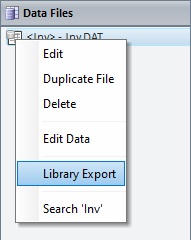
3. In the resulting menu, select "Library Export" to open the "Export to Library" window.
If required, select a different source library or rename it by clicking ![]() . See To Define a Library.
. See To Define a Library.

4. Fill in the following options:
Data File Information |
|
File Alias |
Maintain or enter a new file alias. |
Physical File Name |
Maintain or enter a new file name (must be the same as the entered alias). |
Text Box |
If required, add notes regarding the data file being exported. The information will be displayed when the data file is imported into another project. |
Add Data File Resources |
Data files do NOT contain resources. However, you can append project resources to the data file export. Check this option to append all the listed project resources to the selected data file's export. |
![]()
It is possible to append project resources to the data file's export, even though data files cannot contain resources.
a. To view all project resources, click ![]() .
.
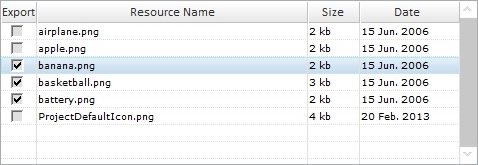
b. Check the project resources you want to include in the export.
c. If you want, click ![]() to hide the resource list.
to hide the resource list.
5. Click ![]() to conclude the export.
to conclude the export.
The exported data file is available in Library ("Data Files" section) and ready to be imported into another project.
![]()
As an alternative, you can use a Drag-and-Drop to initiate an export:
a. Open Library Manager (shortcut key - F4).
b. Drag the data file you want to export and drop it on the Library Manager's window. This opens the corresponding "Export to Library" window.
c. Proceed as described in steps 4 and 5 ("To Export a Data File to Library").
If the Library already contains a data file with the same name, the following message box appears:
a. Click
OR
a. Click
|
To Import a Data File from Library
Step-by-step
1. Use one of the following to access the "Library Manager" window:
a. Go to the "Menu Bar", click "Tools" and, in the resulting menu, select "Library Manager".
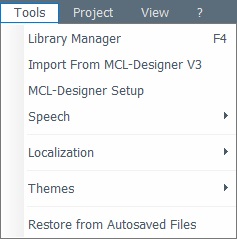
b. Click <F4>.
c. Right click the empty space in the "Data Files" module and select "Library Import" from the drop-down list.
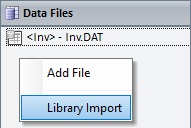
Whichever the option chosen (a, b or c), it opens the "Library Manager" window.
If required, select a different source library or rename it by clicking ![]() . See To Define a Library.
. See To Define a Library.
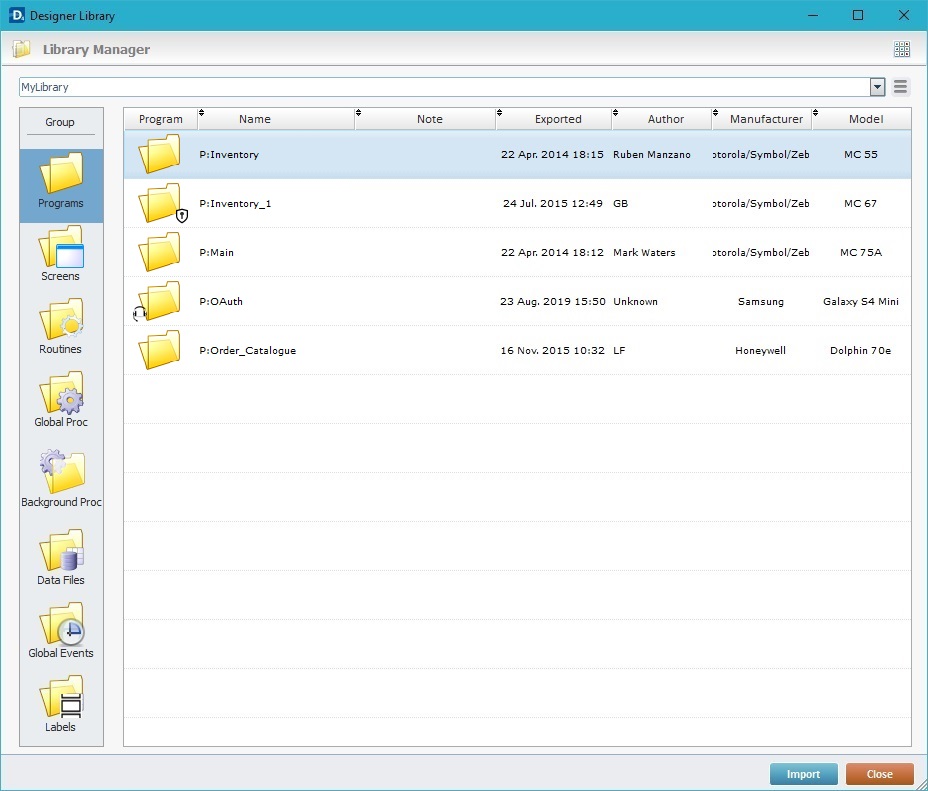
If you used the a or b option, continue to step 2.
If you used option c, proceed to step 3.
2. Select the element type ("Data Files") you want to import in the "Group" section, to the left.

A list of available data files for import is displayed.
3. Use one of the following to access the "Import into Project" window and continue the import operation:
a. Double-click the desired data file.
b. Drag and drop it into the "Data Files" module area.

c. Select the intended data file and click ![]() .
.
d. Right-click the selected data file and click the "Import to Project" option.

The corresponding "Import into Project" window opens.

This window displays information that cannot be edited (regarding the data file being imported) and information you can edit (the "Destination" section).
![]() If the destination project contains a data file with the same alias/name as the data file being imported, the alias/name of the imported data file will automatically change to "..._X" ("X "refers to an incremental number.
If the destination project contains a data file with the same alias/name as the data file being imported, the alias/name of the imported data file will automatically change to "..._X" ("X "refers to an incremental number.
4. Maintain or enter new information, as required by the project.
Import Data File |
Displays the data file's alias. NOT editable. |
Displays the data file's author and when the data file was added to the library. It can also include notes entered during the export into Library operation. NOT editable. |
|
Destination |
|
File Alias |
Maintain the suggestion or enter a new alias for the imported data file. Make sure the destination project does not include a data file with the same alias or the imported data file will overwrite the one that already exists in the destination project. |
Physical File Name |
Maintain the suggestion or enter a new name (must be the same as the entered alias). |
Import Data File Resources (x) |
Data files do NOT contain resources. However, if you have previously exported a data file into Library with project resources, when you import that data file into a new project, you have the choice to append those project resources to the data file import. Check this option to append all the listed resources to the selected data file's import. |
![]()
It is possible to append project resources (appended during the data file's export into the Library - see To Export a Data File to Library) to the data file's import, even though they are not included in the data file.
a. To view all project resources, click ![]() .
.

b. Check the project resources you want to include in the import.
c. If you want, click ![]() to hide the resource list.
to hide the resource list.
5. If there are no issues, click ![]() to conclude the import.
to conclude the import.
The newly imported data file is displayed in the "Data Files" module and ready to be used in the project.
The
•The current project contains a data file with the same name as the one to be imported. •The current project contains a data file with the same physical file name as the one to be imported.
Corrective action:
a. Enter a new data file alias/physical name that does not exist in the current project. b. Click
The •The data file's alias and physical file name do not match. They must be the same.
Corrective action:
a. Enter the same data file alias and physical file name.
b. Click
|
Corrective action:
a. Click
OR
a. Click
b. Click
Corrective action:
a. Click
b. Click
|